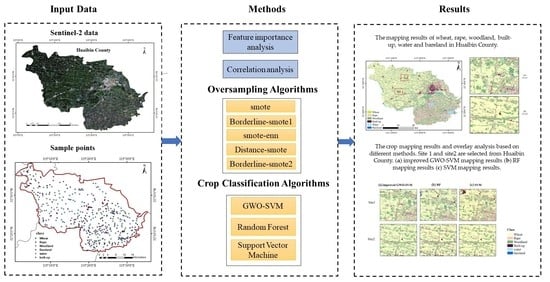Feature-Ensemble-Based Crop Mapping for Multi-Temporal Sentinel-2 Data Using Oversampling Algorithms and Gray Wolf Optimizer Support Vector Machine
Abstract
:1. Introduction
2. Study Area and Datasets
2.1. Study Area
2.2. Datasets
2.2.1. Sentinel-2 Data
2.2.2. Field Sample Data
2.2.3. Visual Interpretation Data
3. Methods
3.1. Time Series Vegetation Indexes
3.2. Feature Variable Optimization
3.3. Oversampling Algorithm
3.4. Selection of Classification Algorithms
3.5. Accuracy Evaluation
4. Results
4.1. Feature Importance Analysis and Correlation Analysis
4.2. Performance with Different Oversampling Algorithms
4.3. Comparison of Different Classification Methods
5. Discussion
5.1. The Significance of Feature Selection
5.2. Role of Oversampling Algorithms
5.3. Compare Different Classification Algorithms
6. Conclusions
Author Contributions
Funding
Institutional Review Board Statement
Informed Consent Statement
Conflicts of Interest
References
- Adrian, J.; Sagan, V.; Maimaitijiang, M. Sentinel SAR-optical fusion for crop type mapping using deep learning and Google Earth Engine. Isprs J. Photogramm. 2021, 175, 215–235. [Google Scholar] [CrossRef]
- Brinkhoff, J.; Vardanega, J.; Robson, A.J. Land Cover Classification of Nine Perennial Crops Using Sentinel-1 and-2 Data. Remote Sens. 2020, 12, 96. [Google Scholar] [CrossRef] [Green Version]
- Phiri, D.; Simwanda, M.; Salekin, S.; Nyirenda, V.R.; Murayama, Y.; Ranagalage, M. Sentinel-2 Data for Land Cover/Use Mapping: A Review. Remote Sens. 2020, 12, 2291. [Google Scholar] [CrossRef]
- Zhang, C.Y.; Marzougui, A.; Sankaran, S. High-resolution satellite imagery applications in crop phenotyping: An overview. Comput. Electron. Agric. 2020, 175, 105584. [Google Scholar] [CrossRef]
- Qadir, A.; Mondal, P. Synergistic Use of Radar and Optical Satellite Data for Improved Monsoon Cropland Mapping in India. Remote Sens. 2020, 12, 522. [Google Scholar] [CrossRef] [Green Version]
- Ramadhani, F.; Pullanagari, R.; Kereszturi, G.; Procter, J. Automatic Mapping of Rice Growth Stages Using the Integration of SENTINEL-2, MOD13Q1, and SENTINEL-1. Remote Sens. 2020, 12, 3613. [Google Scholar] [CrossRef]
- Dheeravath, V.; Thenkabail, P.S.; Chandrakantha, G.; Noojipady, P.; Reddy, G.P.O.; Biradar, C.M.; Gumma, M.K.; Velpuri, M. Irrigated areas of India derived using MODIS 500 m time series for the years 2001–2003. Isprs J. Photogramm. 2010, 65, 42–59. [Google Scholar] [CrossRef]
- Potgieter, A.B.; Apan, A.; Hammer, G.; Dunn, P. Early-season crop area estimates for winter crops in NE Australia using MODIS satellite imagery. Isprs J. Photogramm. 2010, 65, 380–387. [Google Scholar] [CrossRef]
- Zhang, B.; Liu, X.; Liu, M.; Meng, Y. Detection of Rice Phenological Variations under Heavy Metal Stress by Means of Blended Landsat and MODIS Image Time Series. Remote Sens. 2019, 11, 13. [Google Scholar] [CrossRef] [Green Version]
- Yang, H.J.; Pan, B.; Wu, W.F.; Tai, J.H. Field-based rice classification in Wuhua county through integration of multi-temporal Sentinel-1A and Landsat-8 OLI data. Int. J. Appl. Earth Obs. 2018, 69, 226–236. [Google Scholar] [CrossRef]
- Bolivar-Santamaria, S.; Reu, B. Detection and characterization of agroforestry systems in the Colombian Andes using Sentinel-2 imagery. Agrofor. Syst. 2021, 95, 499–514. [Google Scholar] [CrossRef]
- Ren, T.W.; Liu, Z.; Zhang, L.; Liu, D.Y.; Xi, X.J.; Kang, Y.H.; Zhao, Y.Y.; Zhang, C.; Li, S.M.; Zhang, X.D. Early Identification of Seed Maize and Common Maize Production Fields Using Sentinel-2 Images. Remote Sens. 2020, 12, 2140. [Google Scholar] [CrossRef]
- Preidl, S.; Lange, M.; Doktor, D. Introducing APiC for regionalised land cover mapping on the national scale using Sentinel-2A imagery. Remote Sens. Environ. 2020, 240, 111673. [Google Scholar] [CrossRef]
- Granzig, T.; Fassnacht, F.E.; Kleinschmit, B.; Forster, M. Mapping the fractional coverage of the invasive shrub Ulex europaeus with multi-temporal Sentinel-2 imagery utilizing UAV orthoimages and a new spatial optimization approach. Int. J. Appl. Earth Obs. 2021, 96, 102281. [Google Scholar] [CrossRef]
- Wang, X.Y.; Guo, Y.G.; He, J.; Du, L.T. Fusion of HJ1B and ALOS PALSAR data for land cover classification using machine learning methods. Int. J. Appl. Earth Obs. 2016, 52, 192–203. [Google Scholar] [CrossRef]
- Tetila, E.C.; Machado, B.B.; Belete, N.A.D.; Guimaraes, D.A.; Pistori, H. Identification of Soybean Foliar Diseases Using Unmanned Aerial Vehicle Images. IEEE Geosci. Remote Sens. Lett. 2017, 14, 2190–2194. [Google Scholar] [CrossRef]
- Sinha, P.; Robson, A.; Schneider, D.; Kilic, T.; Mugera, H.K.; Ilukor, J.; Tindamanyire, J.M. The potential of in-situ hyperspectral remote sensing for differentiating 12 banana genotypes grown in Uganda. Isprs J. Photogramm. 2020, 167, 85–103. [Google Scholar] [CrossRef]
- Sonobe, R.; Yamaya, Y.; Tani, H.; Wang, X.F.; Kobayashi, N.; Mochizuki, K. Mapping crop cover using multi-temporal Landsat 8 OLI imagery. Int. J. Remote Sens. 2017, 38, 4348–4361. [Google Scholar] [CrossRef] [Green Version]
- Zhang, H.Y.; Du, H.Y.; Zhang, C.K.; Zhang, L.P. An automated early-season method to map winter wheat using time-series Sentinel-2 data: A case study of Shandong, China. Comput. Electron. Agric. 2021, 182, 105962. [Google Scholar] [CrossRef]
- Asgarian, A.; Soffianian, A.; Pourmanafi, S. Crop type mapping in a highly fragmented and heterogeneous agricultural landscape: A case of central Iran using multi-temporal Landsat 8 imagery. Comput. Electron. Agric. 2016, 127, 531–540. [Google Scholar] [CrossRef]
- Gallo, I.; La Grassa, R.; Landro, N.; Boschetti, M. Sentinel 2 Time Series Analysis with 3D Feature Pyramid Network and Time Domain Class Activation Intervals for Crop Mapping. Isprs Int. J. Geo-Inf. 2021, 10, 483. [Google Scholar] [CrossRef]
- Skakun, S.; Franch, B.; Vermote, E.; Roger, J.C.; Becker-Reshef, I.; Justice, C.; Kussul, N. Early season large-area winter crop mapping using MODIS NDVI data, growing degree days information and a Gaussian mixture model. Remote Sens. Environ. 2017, 195, 244–258. [Google Scholar] [CrossRef]
- Pageot, Y.; Baup, F.; Inglada, J.; Baghdadi, N.; Demarez, V. Detection of Irrigated and Rainfed Crops in Temperate Areas Using Sentinel-1 and Sentinel-2 Time Series. Remote Sens. 2020, 12, 3044. [Google Scholar] [CrossRef]
- Wang, L.J.; Wang, J.Y.; Zhang, X.W.; Wang, L.G.; Qin, F. Deep segmentation and classification of complex crops using multi-feature satellite imagery. Comput. Electron. Agric. 2022, 200, 107249. [Google Scholar] [CrossRef]
- Wang, L.J.; Wang, J.Y.; Liu, Z.Z.; Zhu, J.; Qin, F. Evaluation of a deep-learning model for multispectral remote sensing of land use and crop classification. Crop J. 2022, 10, 1435–1451. [Google Scholar] [CrossRef]
- Sitokonstantinou, V.; Papoutsis, I.; Kontoes, C.; Lafarga Arnal, A.; Armesto Andres, A.P.; Garraza Zurbano, J.A. Scalable Parcel-Based Crop Identification Scheme Using Sentinel-2 Data Time-Series for the Monitoring of the Common Agricultural Policy. Remote Sens. 2018, 10, 911. [Google Scholar] [CrossRef] [Green Version]
- Pena, J.M.; Gutierrez, P.A.; Hervas-Martinez, C.; Six, J.; Plant, R.E.; Lopez-Granados, F. Object-Based Image Classification of Summer Crops with Machine Learning Methods. Remote Sens. 2014, 6, 5019–5041. [Google Scholar] [CrossRef] [Green Version]
- Arango, R.B.; Campos, A.M.; Combarro, E.F.; Canas, E.R.; Diaz, I. Mapping cultivable land from satellite imagery with clustering algorithms. Int. J. Appl. Earth Obs. 2016, 49, 99–106. [Google Scholar] [CrossRef]
- Pena-Arancibia, J.L.; McVicar, T.R.; Paydar, Z.; Li, L.T.; Guerschman, J.P.; Donohue, R.J.; Dutta, D.; Podger, G.M.; van Dijk, A.I.J.M.; Chiew, F.H.S. Dynamic identification of summer cropping irrigated areas in a large basin experiencing extreme climatic variability. Remote Sens. Environ. 2014, 154, 139–152. [Google Scholar] [CrossRef]
- de Castro, H.C.; de Carvalho, O.A.; de Carvalho, O.L.F.; de Bem, P.P.; de Moura, R.D.; de Albuquerque, A.O.; Silva, C.R.; Ferreira, P.H.G.; Guimaraes, R.F.; Gomes, R.A.T. Rice Crop Detection Using LSTM, Bi-LSTM, and Machine Learning Models from Sentinel-1 Time Series. Remote Sens. 2020, 12, 2655. [Google Scholar]
- Sheykhmousa, M.; Mahdianpari, M.; Ghanbari, H.; Mohammadimanesh, F.; Ghamisi, P.; Homayouni, S. Support Vector Machine Versus Random Forest for Remote Sensing Image Classification: A Meta-Analysis and Systematic Review. IEEE J. Stars 2020, 13, 6308–6325. [Google Scholar] [CrossRef]
- Li, R.Y.; Xu, M.Q.; Chen, Z.Y.; Gao, B.B.; Cai, J.; Shen, F.X.; He, X.L.; Zhuang, Y.; Chen, D.L. Phenology-based classification of crop species and rotation types using fused MODIS and Landsat data: The comparison of a random-forest-based model and a decision-rule-based model. Soil Tillage Res. 2021, 206, 104838. [Google Scholar] [CrossRef]
- Xu, J.F.; Zhu, Y.; Zhong, R.H.; Lin, Z.X.; Xu, J.L.; Jiang, H.; Huang, J.F.; Li, H.F.; Lin, T. DeepCropMapping: A multi-temporal deep learning approach with improved spatial generalizability for dynamic corn and soybean mapping. Remote Sens. Environ. 2020, 247, 111946. [Google Scholar] [CrossRef]
- Samui, P.; Gowda, P.H.; Oommen, T.; Howell, T.A.; Marek, T.H.; Porter, D.O. Statistical learning algorithms for identifying contrasting tillage practices with Landsat Thematic Mapper data. Int. J. Remote Sens. 2012, 33, 5732–5745. [Google Scholar] [CrossRef]
- Low, F.; Michel, U.; Dech, S.; Conrad, C. Impact of feature selection on the accuracy and spatial uncertainty of per-field crop classification using Support Vector Machines. Isprs J. Photogramm. 2013, 85, 102–119. [Google Scholar] [CrossRef]
- Lin, M.; Zhu, X.; Hua, T.; Tang, X.; Tu, G.; Chen, X. Detection of Ionospheric Scintillation Based on XGBoost Model Improved by SMOTE-ENN Technique. Remote Sens. 2021, 13, 2577. [Google Scholar] [CrossRef]
- Wang, N.; Cheng, W.M.; Zhao, M.; Liu, Q.Y.; Wang, J. Identification of the Debris Flow Process Types within Catchments of Beijing Mountainous Area. Water 2019, 11, 638. [Google Scholar] [CrossRef] [Green Version]
- Farrar, T.J.; Nicholson, S.E.; Lare, A.R. The influence of soil type on the relationships between NDVI, rainfall, and soil moisture in semiarid Botswana. II. NDVI response to soil moisture. Remote Sens. Environ. 1994, 50, 121–133. [Google Scholar] [CrossRef]
- Liu, H.Q.; Huete, A. A Feedback Based Modification of the Ndvi to Minimize Canopy Background and Atmospheric Noise. IEEE T Geosci. Remote 1995, 33, 457–465. [Google Scholar] [CrossRef]
- Huete, A.R. A soil-adjusted vegetation index (SAVI). Remote Sens. Environ. 1988, 25, 295–309. [Google Scholar] [CrossRef]
- McFeeters, S.K. The use of the normalized difference water index (NDWI) in the delineation of open water features. Int. J. Remote Sens. 1996, 17, 1425–1432. [Google Scholar] [CrossRef]
- Zha, Y.; Gao, J.; Ni, S. Use of normalized difference built-up index in automatically mapping urban areas from TM imagery. Int. J. Remote Sens. 2003, 24, 583–594. [Google Scholar] [CrossRef]
- Valcarce-Dineiro, R.; Arias-Perez, B.; Lopez-Sanchez, J.M.; Sanchez, N. Multi-Temporal Dual- and Quad-Polarimetric Synthetic Aperture Radar Data for Crop-Type Mapping. Remote Sens. 2019, 11, 1518. [Google Scholar] [CrossRef] [Green Version]
- .Chawla, N.V.; Bowyer, K.W.; Hall, L.O.; Kegelmeyer, W.P. SMOTE: Synthetic minority over-sampling technique. J. Artif. Intell. Res. 2002, 16, 321–357. [Google Scholar] [CrossRef]
- Han, H.; Wang, W.Y.; Mao, B.H. Borderline-SMOTE: A New Over-Sampling Method in Imbalanced Data Sets Learning. In Advances in Intelligent Computing, Pt 1, Proceedings; Huang, D.S., Zhang, X.P., Huang, G.B., Eds.; Lecture Notes in Computer Science; Springer: Berlin, Germany, 2005; Volume 3644, pp. 878–887. [Google Scholar]
- Bunkhumpornpat, C.; Sinapiromsaran, K.; Lursinsap, C. DBSMOTE: Density-Based Synthetic Minority Over-sampling TEchnique. Appl. Intell. 2012, 36, 664–684. [Google Scholar] [CrossRef]
- Mirjalili, S.; Mirjalili, S.M.; Lewis, A. Grey Wolf Optimizer. Adv. Eng. Softw. 2014, 69, 46–61. [Google Scholar] [CrossRef] [Green Version]
- Sweidan, A.H.; El-Bendary, N.; Hassanien, A.E.; Hegazy, O.M.; Mohamed, A.E.-K. Water Quality Classification Approach based on Bio-Inspired Gray Wolf Optimization. In Proceedings of the 2015 Seventh International Conference of Soft Computing and Pattern Recognition, Fukuoka, Japan, 13–15 November 2015; Koppen, M., Xue, B., Takagi, H., Abraham, A., Muda, A.K., Ma, K., Eds.; IEEE: Piscataway, NJ, USA, 2015; pp. 1–6. [Google Scholar]
- Mercier, A.; Betbeder, J.; Baudry, J.; Le Roux, V.; Spicher, F.; Lacoux, J.; Roger, D.; Hubert-Moy, L. Evaluation of Sentinel-1 & 2 time series for predicting wheat and rapeseed phenological stages. Isprs J. Photogramm. 2020, 163, 231–256. [Google Scholar]
- Wang, L.J.; Wang, J.Y.; Qin, F. Feature Fusion Approach for Temporal Land Use Mapping in Complex Agricultural Areas. Remote Sens. 2021, 13, 2517. [Google Scholar] [CrossRef]


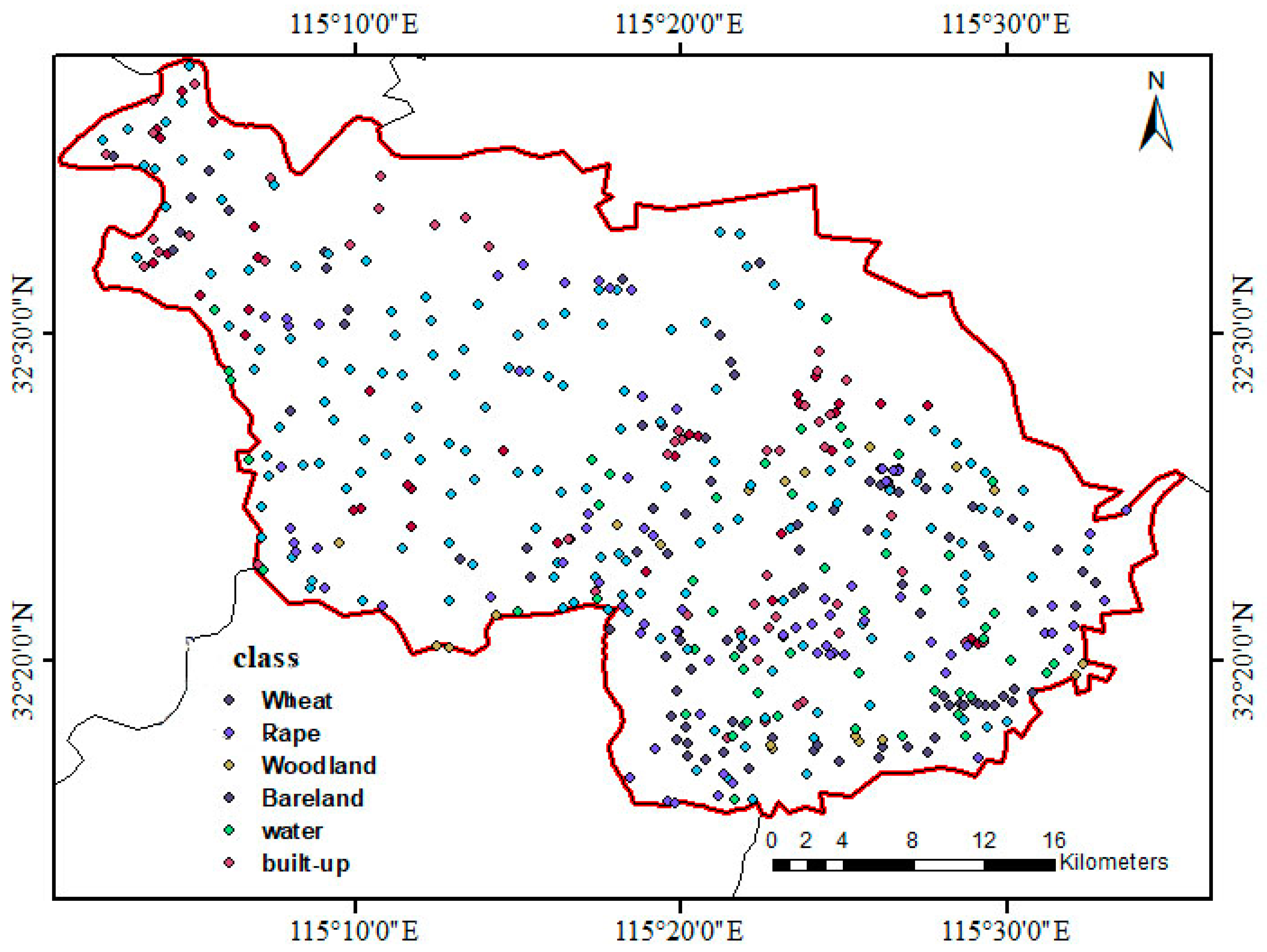
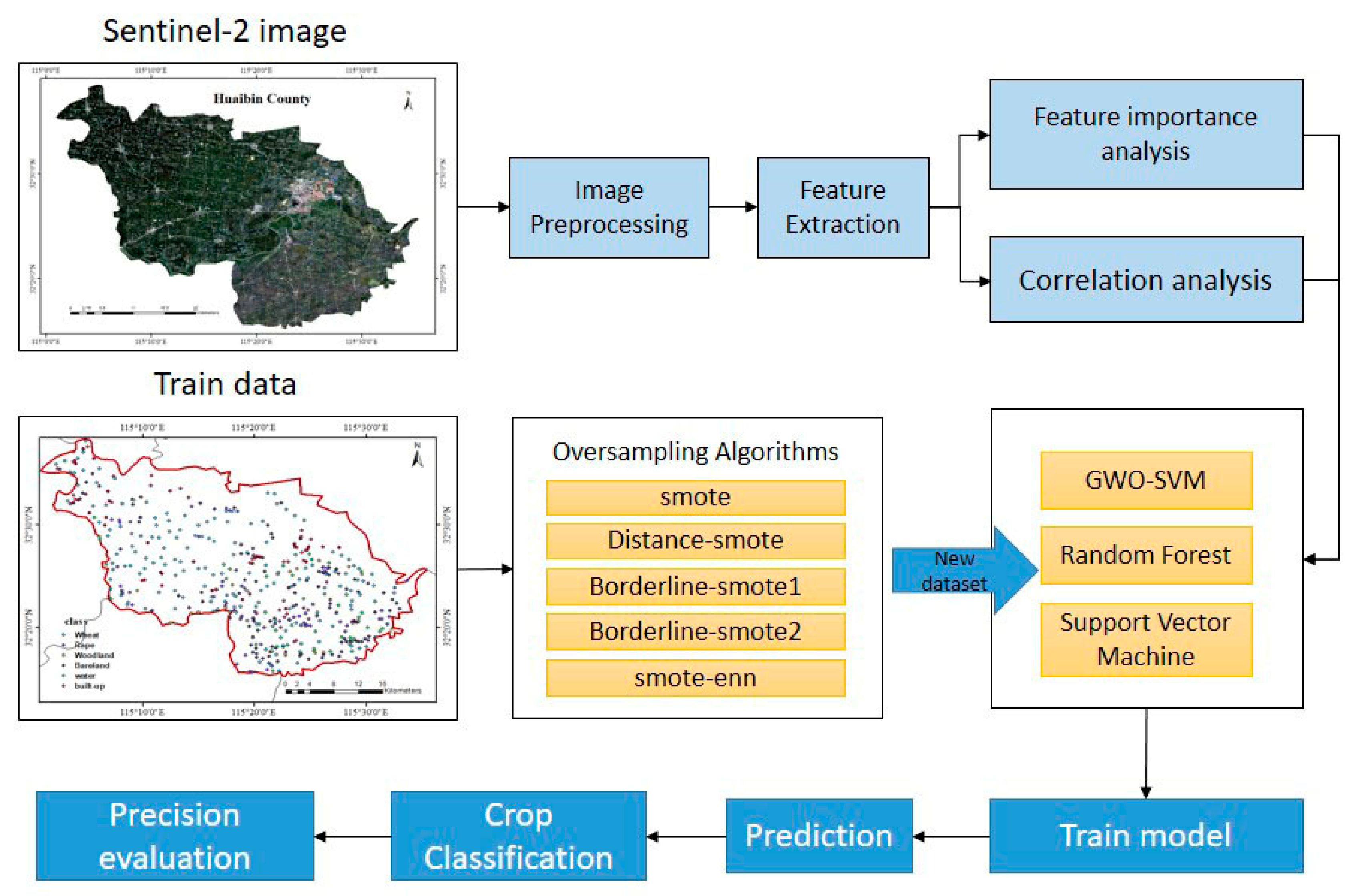
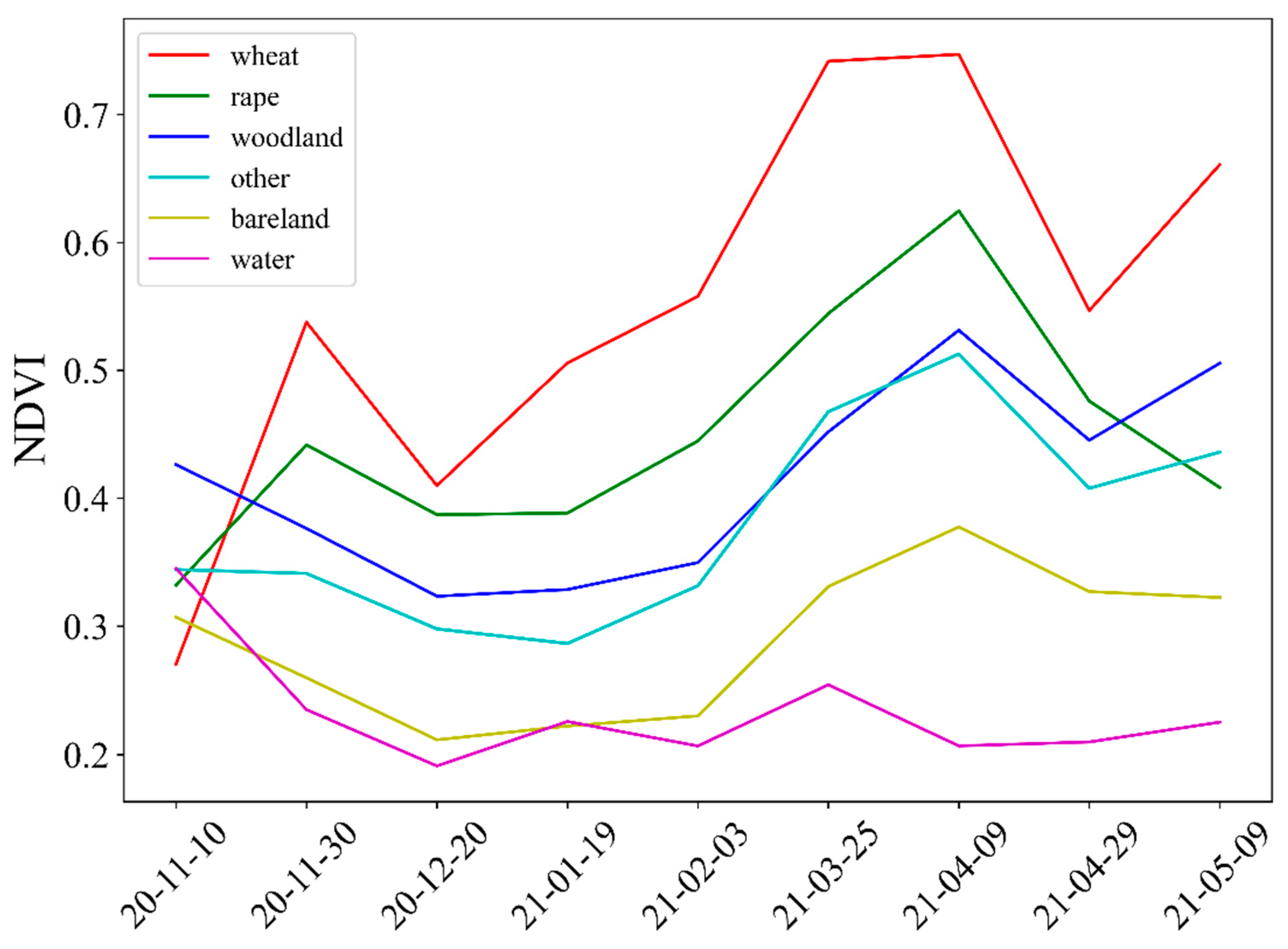
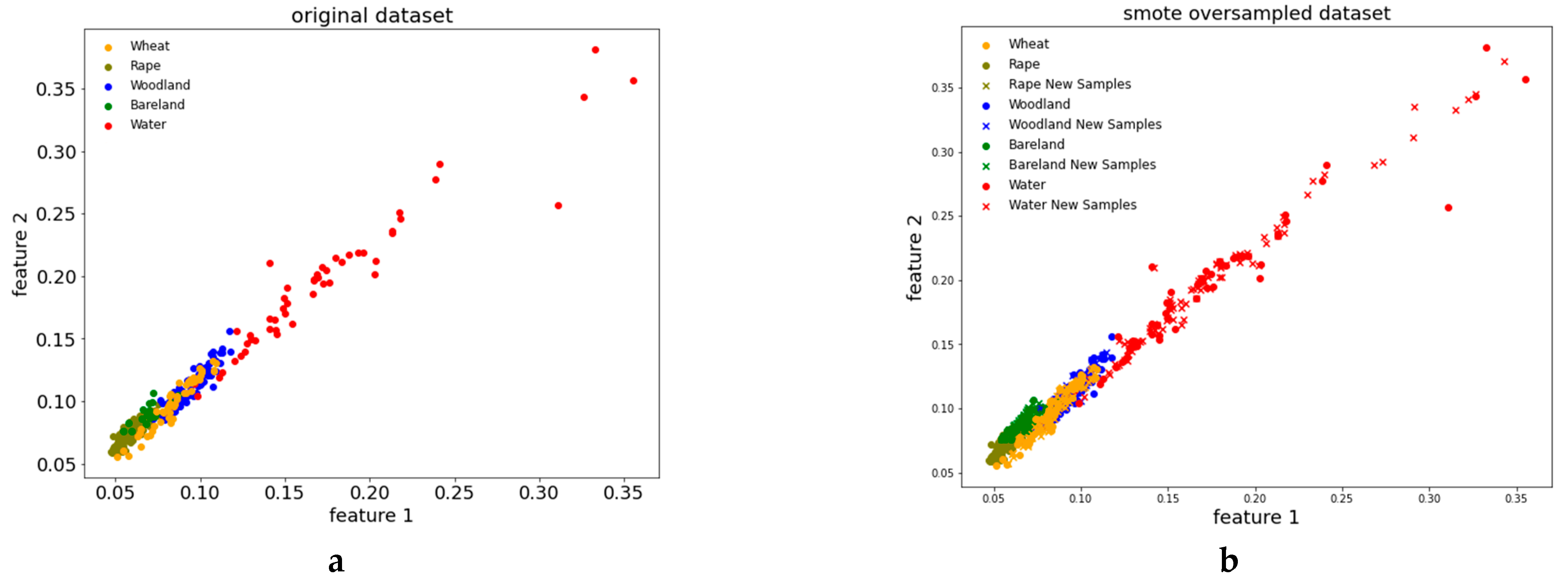
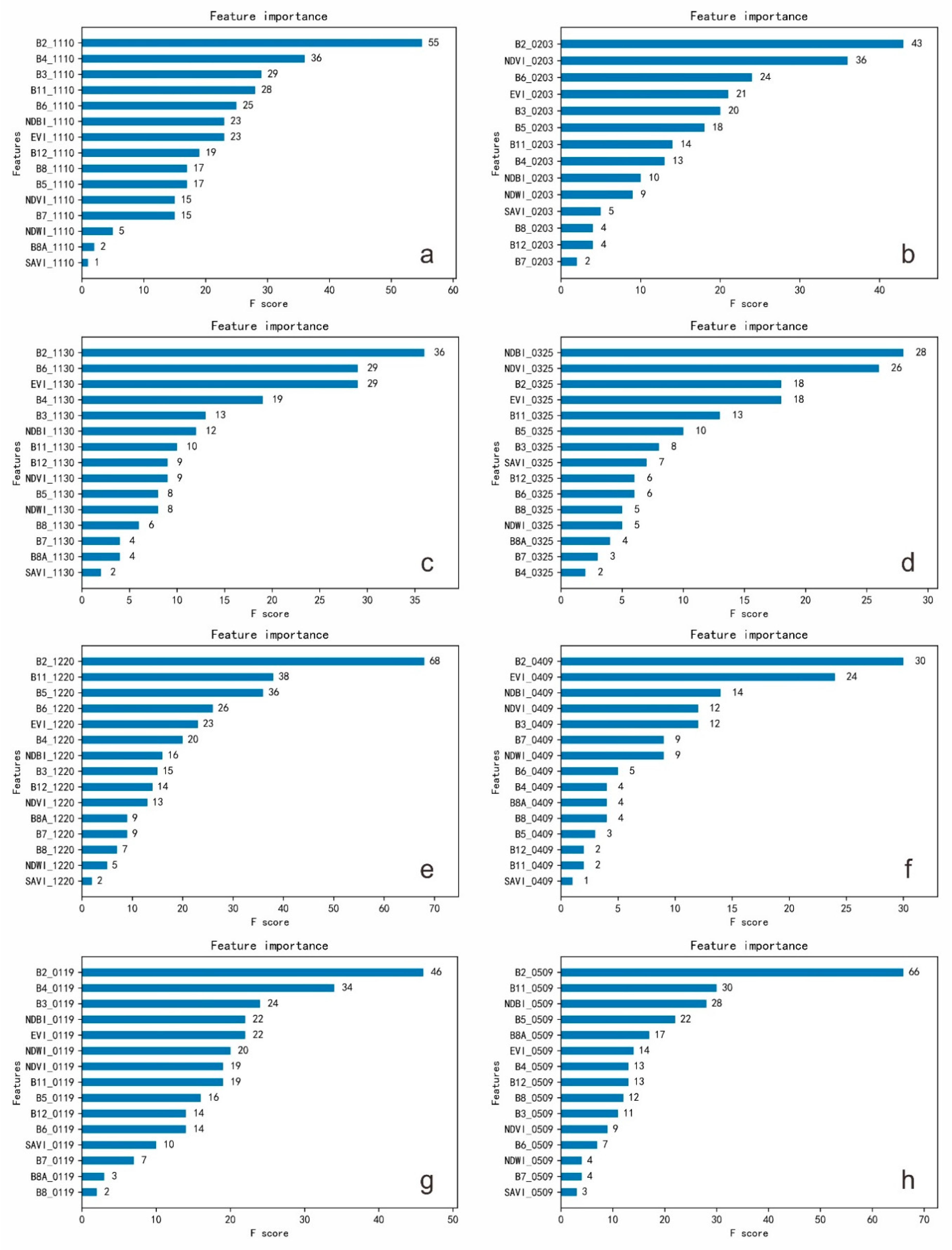


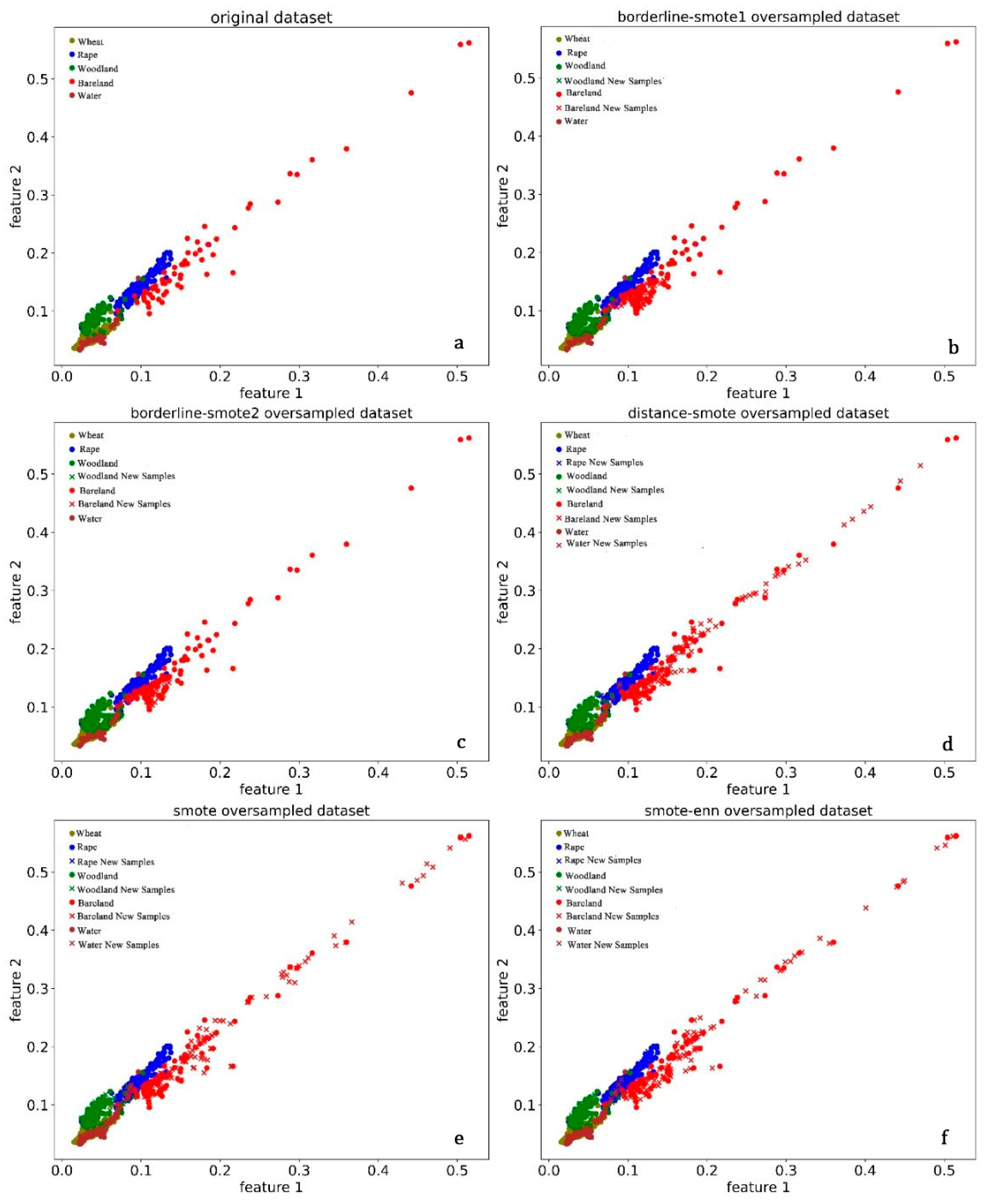


| Bands | Description | Center Wavelength Bandwidth (nm) | Resolution |
|---|---|---|---|
| B1 | Coastal aerosol | 442.7 | 60 |
| B2 | Blue | 492.4 | 10 |
| B3 | Green | 559.8 | 10 |
| B4 | Red | 664.6 | 10 |
| B5 | Vegetation Red Edge 1 | 703.9 | 20 |
| B6 | Vegetation Red Edge 2 | 740.5 | 20 |
| B7 | Vegetation Red Edge 3 | 782.8 | 20 |
| B8 | NIR | 832.8 | 10 |
| B8A | Narrow NIR | 864.7 | 20 |
| B9 | Water vapour | 945.2 | 60 |
| B10 | SWIR-Cirrus | 1376.9 | 60 |
| B11 | SWIR1 | 1613.7 | 20 |
| B12 | SWIR2 | 2202.4 | 20 |
| Crop | The Numbers of Sample Points | Percent |
|---|---|---|
| Wheat | 174 | 51.32% |
| Rape | 68 | 20.17% |
| Woodland | 14 | 4.15% |
| Other crops | 24 | 7.12% |
| Bare land | 54 | 16.02% |
| Water | 3 | 0.089% |
| Crop | The Numbers of Sample Points | Percent |
|---|---|---|
| Wheat | 156 | 45.61% |
| Rape | 88 | 25.73% |
| Woodland | 17 | 4.97% |
| Bareland | 50 | 14.61% |
| Water | 13 | 3.80% |
| Built-up | 18 | 5.26% |
| Vegetation Indexes | Equations |
|---|---|
| Normalized Difference Vegetation Index (NDVI) | NDVI = (NIR − R)/(NIR + R) [38] |
| Enhanced Vegetation Index (EVI) | EVI = 2.5 × (NIR − R)/(NIR + 6R − 7.5B + 1) [39] |
| Soil Regulation vegetation Index (SAVI) | SAVI = (1 + L)1(NIR − R)/(NIR) [40] |
| Normalized Difference Water Index (NDWI) | NDWI = (G − NIR)/(G + NIR) [41] |
| Normalized Difference Built-up Index (NDBI) | NDBI = (SWIR − NIR)/(SWIR + NIR) [42] |
| Oversampling Technology | Raw Data | Smote | Smote-enn | Borderline-smote1 | Borderline-smote2 | Distance-smote | |
|---|---|---|---|---|---|---|---|
| PA | Wheat | 0.96 | 0.98 | 0.97 | 0.98 | 0.98 | 0.99 |
| Rape | 0.79 | 0.90 | 0.85 | 0.93 | 0.92 | 0.91 | |
| Woodland | 0.76 | 0.81 | 0.75 | 0.75 | 0.78 | 0.82 | |
| UA | Wheat | 0.95 | 0.91 | 0.96 | 0.93 | 0.95 | 0.98 |
| Rape | 0.93 | 0.99 | 0.93 | 1.00 | 0.97 | 0.98 | |
| Woodland | 0.59 | 0.77 | 0.68 | 0.71 | 0.70 | 0.93 | |
| F1 score | Wheat | 0.96 | 0.95 | 0.96 | 0.97 | 0.95 | 0.96 |
| Rape | 0.85 | 0.86 | 0.81 | 0.92 | 0.91 | 0.90 | |
| Woodland | 0.67 | 0.86 | 0.71 | 0.83 | 0.78 | 0.84 | |
| Accuracy (%) | 0.8940 | 0.9224 | 0.9206 | 0.9334 | 0.9358 | 0.9636 | |
| Classification | Improved GWO-SVM | RF | SVM | |
|---|---|---|---|---|
| OA | 0.9636 | 0.9558 | 0.9525 | |
| F1 score | 0.96 | 0.98 | 0.94 | |
| Wheat | PA | 0.99 | 0.99 | 1.00 |
| UA | 0.98 | 0.97 | 0.98 | |
| Rape | PA | 0.91 | 0.86 | 0.83 |
| UA | 0.98 | 0.94 | 0.96 | |
| Woodland | PA | 0.82 | 0.83 | 0.82 |
| UA | 0.93 | 0.93 | 0.93 | |
| Bareland | PA | 0.83 | 0.79 | 0.98 |
| UA | 0.79 | 0.78 | 0.78 | |
| Water | PA | 0.97 | 0.95 | 0.96 |
| UA | 0.97 | 0.96 | 0.93 | |
| Built-up | PA | 1.00 | 0.98 | 1.00 |
| UA | 0.89 | 0.82 | 0.78 | |
Publisher’s Note: MDPI stays neutral with regard to jurisdictional claims in published maps and institutional affiliations. |
© 2022 by the authors. Licensee MDPI, Basel, Switzerland. This article is an open access article distributed under the terms and conditions of the Creative Commons Attribution (CC BY) license (https://creativecommons.org/licenses/by/4.0/).
Share and Cite
Zhang, H.; Gao, M.; Ren, C. Feature-Ensemble-Based Crop Mapping for Multi-Temporal Sentinel-2 Data Using Oversampling Algorithms and Gray Wolf Optimizer Support Vector Machine. Remote Sens. 2022, 14, 5259. https://doi.org/10.3390/rs14205259
Zhang H, Gao M, Ren C. Feature-Ensemble-Based Crop Mapping for Multi-Temporal Sentinel-2 Data Using Oversampling Algorithms and Gray Wolf Optimizer Support Vector Machine. Remote Sensing. 2022; 14(20):5259. https://doi.org/10.3390/rs14205259
Chicago/Turabian StyleZhang, Haitian, Maofang Gao, and Chao Ren. 2022. "Feature-Ensemble-Based Crop Mapping for Multi-Temporal Sentinel-2 Data Using Oversampling Algorithms and Gray Wolf Optimizer Support Vector Machine" Remote Sensing 14, no. 20: 5259. https://doi.org/10.3390/rs14205259





